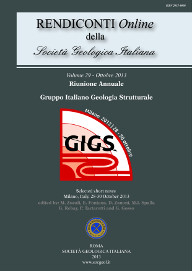
Microstructures and LPO as indicators of strain partition in metamorphic tectonites: the example of the Eclogite Micaschists Complex (Sesia-Lanzo Zone, Austroalpine domain, Western Alps, Italy)
Michele Zucali (a), Alice Vho (a), Daniel Chateigner (b), Luca Lutterotti (b) & Bachir Ouladdiaf (c)
(a) Department of Earth Sciences , Università degli Studi di Milano, Via Mangiagalli 34, Milano, Italy. E-mail: michele.zucali@unimi.it
(b) CRISMAT-ENSICAEN and IUT-Caen, Université de Caen Basse-Normandie, campus 2, 6, Bd. M. Juin 14050 Caen, France.
(c) Institut Laue-Langevin 6, Rue Jules Horowitz, B.P.156 , 38042 Grenoble Cedex 9, France.
Volume: 29/2013
Pages: 202-205
Abstract
We studied microstructures and lattice preferred orientation (LPO) of the Eclogite Micaschists Complex (EMC) metapelites and metabasites. The EMC belongs to the Sesia-Lanzo Zone of the Austrolapine domain of the Western Alps (Italy). The Sesia-Lanzo Zone is a fragment of the Adria plate continental lithosphere, involved in the alpine subduction. The alpine imprint on the Sesia-Lanzo rocks is characterised by penetrative superimposed foliations, developed under eclogite facies conditions and marked by millimetre- to centimetre-size aggregates.
The microstructural analysis revealed a multi-stage evolution: i) pre-S1 mm-thin aggregate of quartz, white mica and rutile as inclusions within S1 garnet porphyroblasts; ii) S1 millimetre foliation defined by white mica and garnet; iii) D2 folding produces a axial planar foliation S2 marked by white mica, rutile, glaucophane, omphacite and locally aggregates of garnet; iv) D3 is associated with the reactivation of S2 and the growth of chlorite and green biotite or produces shear planes cutting the S2 foliation and marked by re-crystallized quartz and white mica.
LPO analysis was carried out using original diffraction data collected at the Institut Laue-Langevin (Grenoble) and processed using the Maud software package (Material Analysis Using Diffraction). Only quartz and white mica was studied by texture analysis since other mineral components constitute less then 20% in volume cannot be quantitatively detected by diffraction.
White mica LPO are characterized by (001) pole to planes distributions close to a cluster at high angle to S2 while poles to (010) and (100) describe girdle close to the S2 foliation.
Quartz distributions describe girdle of (100) and (110) poles close to the foliation plane with maxima close to the macroscopic lineation; (001) and (011) poles to planes describe two clusters close to the normal to the S2 foliation.
Several samples, even still displaying broadly same LPO features are also characterised by LPO of quartz more close to a single crystal distribution, likely indicating an important contribution of a static recrystallization.
LPO may be used as additional tool to infer various scale strain partitioning where mesoscopic evidence are lacking.
Keywords
Get Full Text